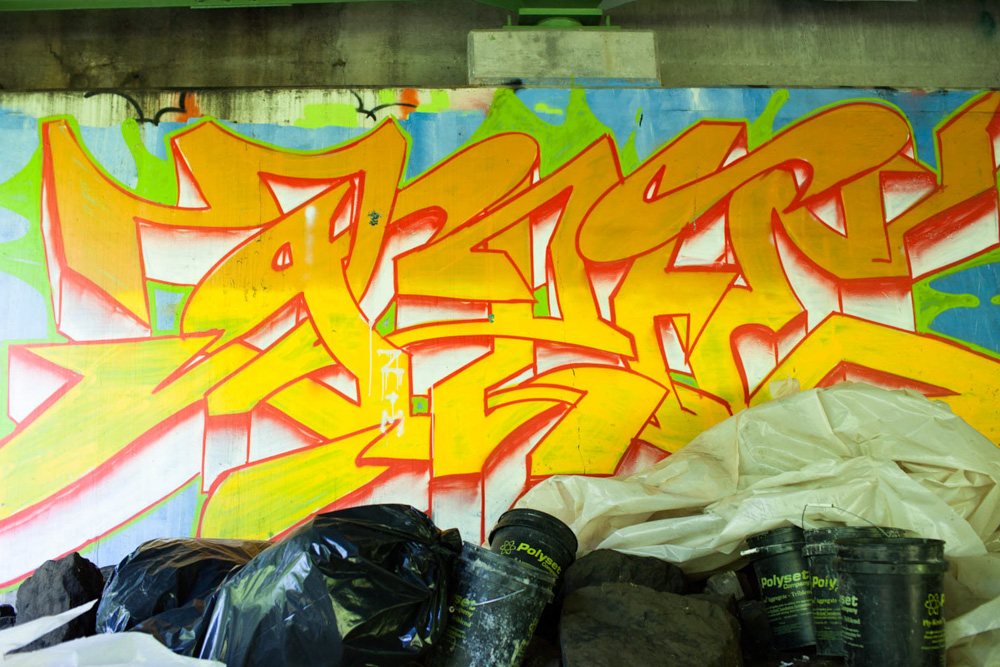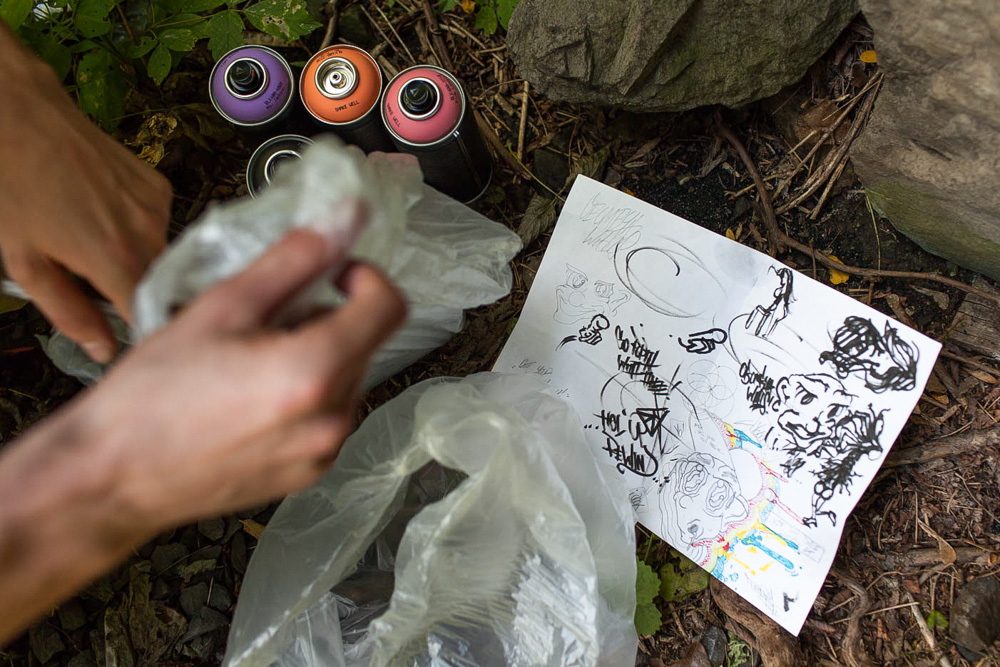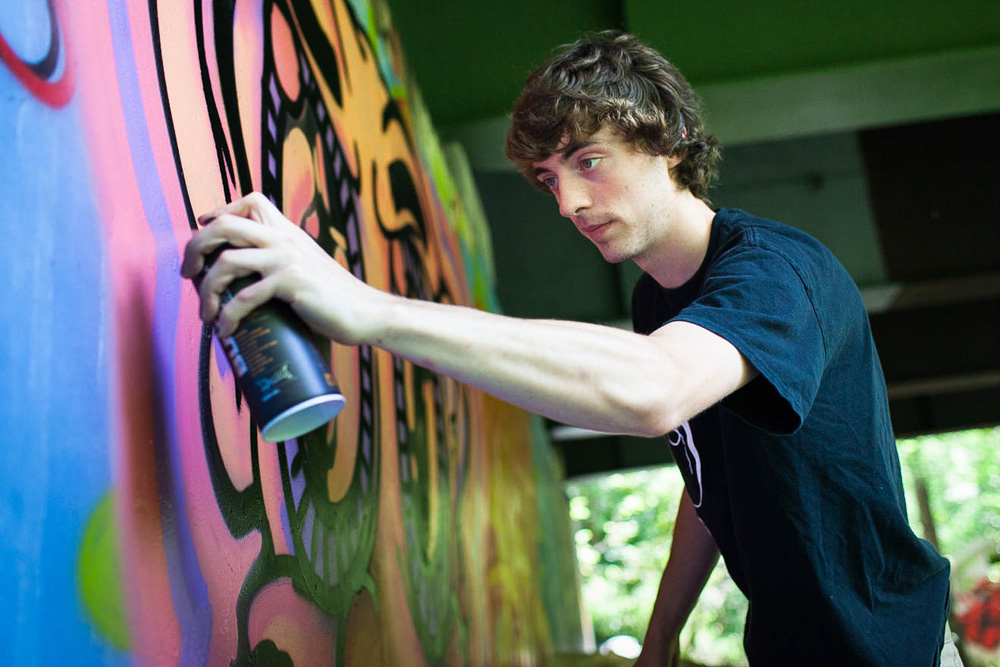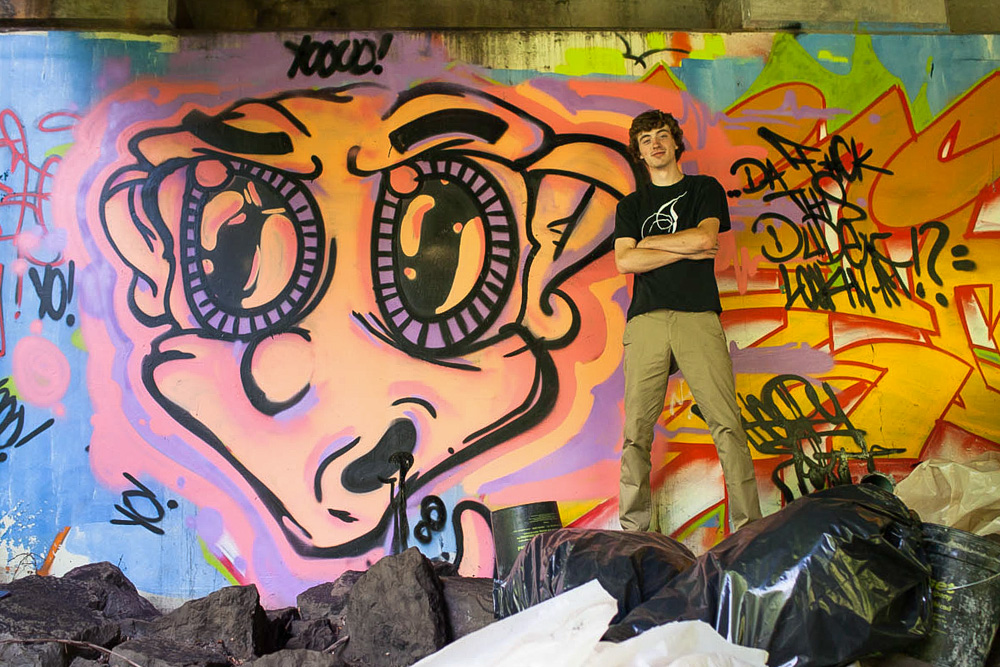The Lost Art
by Gino Fanelli | published Sep. 24th, 2014
It can be any street corner in America. Any abandoned warehouse, any half decayed picket fence. Often chalked up to petty and rebellious teen antics or establishing gang territory, the art of graffi ti perseveres through its gritty exterior. Few and far between pieces glimmer with vibrant neon colors and deep charcoal outlines against the drab concrete backdrop, all through the rattles of Rust-O-Leum spray cans. For the artists behind these works who are so often overlooked or belittled as vandals, providing this bit of beauty to the urban decay makes the stigma and risk of criminal charges worthwhile.
On a quiet, sunny afternoon in Penfield, NY, 21-year-old Alex Vadas swings his black backpack packed with jingling cans of spray paint over his right shoulder. He hops down into a trail off-shooting from a main road leading into Spring Lake Park. A quarter mile walk ensues through a thicket ripe with thorn bushes, fallen tree limbs and a single perilous gap overlooking a sewage run-off line. Finally he reaches a small underpass, the Irondequoit Creek flowing between two embankments reaching up into cement walls riddled with slowly fading graffiti tags. Vadas sets down his pack and pulls out a small notepad filled with rough graphite drawings.
“I studied graphic design at Kent State for a year,” Vadas says, approaching the wall and releasing quick, deliberate sprays of black paint over a deteriorating orange tag. “I guess I just really didn’t see the point. Johnny goes to school to become an accountant, but Johnny doesn’t want to be an accountant, you know?”
Vadas sets down the black can of paint and steps down the embankment, staring up at the rough outline with slight head nods before climbing back up and beginning again, swift pastel-like swipes of purple and blue rapidly filling in the ambient space between the lines.
“I was a pretty straight-edge kid through high school, played sports and all of that,” Vadas says between paint strokes. “Then I guess I got my whole four year college experience in one year. Alcohol violations, got caught stealing paint from Wal-Mart.”
Vadas looks around, eying a bulldozer and other assorted construction equipment left beneath the overpass.
“Yeah, that stuff’s sort of sketching me out, I’m going to try and get this done quick.”
Vadas picks up a pink can and meticulously yet frantically streaks paint into the slowly forming drawing of a caricature-like face.
“I really felt like they were teaching me things I already knew,” he says. “I know how to draw, how to paint. I don’t really want to be a part of the whole corporate structure thing. I want to make something that people see and it makes them want to do something themselves, to spread on the message. Dream, create and inspire. They’re primal thoughts, and I’m just a messenger of them.”
Vadas pauses and stares up at the slowly forming portrait, scratching at the side of his head momentarily before continuing.
“Of course, people see most of it as vandalism, which I get,” Vadas says, gesturing with a nod towards a crudely spray-painted name next to a enameled drawing of a penis, “When it’s just thin lines and gang signs, I get it. But we live in such a gray, shitty world, how could art that makes someone actually feel something be bad?”
Vadas’ sentiment is one that plagues the graffiti artist. The tear between the socially accepted interpretations of what graffiti is and what the art means to him, and in turn what it can mean to others. Of course, tax payer dollars are near infinitely more likely to be invested into the removal of graffiti art rather than providing a controlled area to paint. The 2008-enacted Eraser Defacer program, aimed at graffiti removal city-wide, cost taxpayers $100,000 in its first year with an additional $80,000 being added to tackle the northwest corner of the city and suburbs.
“They really could just make legal walls, just a place where people can go and paint without worrying about getting arrested,” Vadas says “Of course, there are always people who want to do mural work and get recognized. I just like to paint.”
An independent artist, Vadas sees Rochester graffiti crews most notably the mural collective Wall Therapy as a part of this exclusionary scene, aiming more at making names for themselves and preserving their legacy rather than simply creating art.
“I had some problems with those dudes in the past,” Vadas says, spray-painting quick “yo!”s around the portrait. “I was up at Cobbs Hill and I guess I spray-painted over one of Wilson’s, one of their founders, pieces. They got all upset, but I really don’t see why. Things should be about moving forward, not dwelling on the past. They don’t own the wall. Artsy fartsy people love dwelling on the past. I’m not like that. I say either learn from it or forget about it.”
Vadas finishes the piece with a quick writing of “the fuck’s this guy looking at???” before stepping down the embankment.
“I see it like this. It’s different colors to effect different moods. Blue for sadness, red for anger, and so on. I want people to look at things like this and feel the emotion in it. Feel like it’s not just paint on the wall but something that speaks to them personally. That’s what real art is, it’s a personal experience, something that inspires people to spread beauty and emotion from seeing beauty and emotion.”
Vadas stares up at the piece, methodically looking over every stroke, stepping forward to get a closer view and then stepping back again. Finally, he pulls a smartphone from his pocket and snaps a picture. He looks down at the phone and smiles.
“You know, that’s the worst part about being an artist,” he says with a chuckle, “the more you look at it, the more you realize what you could have done differently.”







